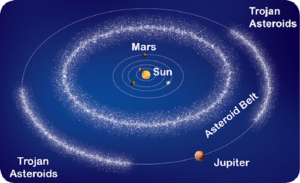In news– NASA’s Lucy mission is on an epic 6-billion-kilometre-long journey to study the Jupiter Trojan asteroids, and nearly one and a half years after it launched, it has finally caught a glimpse of the asteroids.
About Trojan asteroids-
- The Trojan asteroids are some of the more mysterious asteroids that humanity has discovered.
- These asteroids are made up of two swarms, trapped both in front of and behind Jupiter as it orbits our star.
- In 1772 the French mathematician and astronomer Joseph-Louis Lagrange predicted the existence and location of two groups of small bodies located near a pair of gravitationally stable points along Jupiter’s orbit.
- Those are positions (now called Lagrangian points and designated L4 and L5) where a small body can be held, by gravitational forces, at one vertex of an equilateral triangle whose other vertices are occupied by the massive bodies of Jupiter and the Sun.
- There are currently over 4,800 known Trojan asteroids associated with Jupiter.
- About 65% of these belong to the leading group (L4) located 60o in front of Jupiter in its orbit, while the other 35% cluster around the L5 Lagrangian point and trail 60o behind Jupiter.
- Lucy will study the Trojan asteroids to discover if they are, in fact, relics of our early solar system.
- These images are the first in a series of planned observations designed to measure how the Trojan asteroids reflect light at higher angles than is observable from Earth.
- Though the asteroids are still just single points of light in these images, seen against a background of distant stars, the data will help the team choose exposure times for Lucy’s close-up observations of its targets.
- Lucy will fly by these asteroids in 2027 and 2028 as the spacecraft travels through a swarm of small asteroids that lead Jupiter in its orbit around the Sun.
- Lucy is just more than a year into a 12-year voyage that entails close observation of nine of Jupiter’s Trojans the first space mission ever to visit them and two main belt asteroids.

















